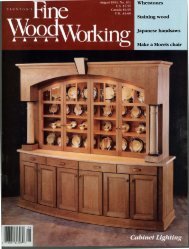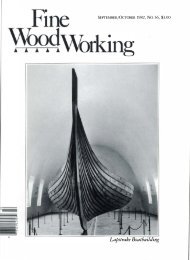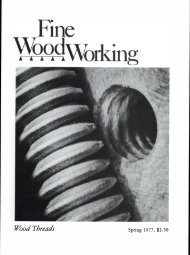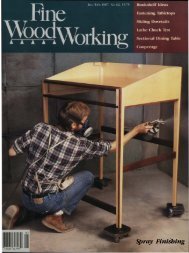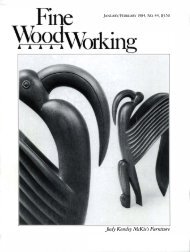NOVEMBER/DECEMBER 1983, No. 43, $3.50 Making ... - Wood Tools
NOVEMBER/DECEMBER 1983, No. 43, $3.50 Making ... - Wood Tools
NOVEMBER/DECEMBER 1983, No. 43, $3.50 Making ... - Wood Tools
You also want an ePaper? Increase the reach of your titles
YUMPU automatically turns print PDFs into web optimized ePapers that Google loves.
tages. First, the saw is always held at the correct angle, freeing<br />
me from the task of sliding work and saw around in search of<br />
the narrow notch in the bird's-mouth. Second, the saw's<br />
hinged upper arm pivots out of the way when a blade must<br />
be threaded through the workpiece. And third, the veneer can<br />
be held stationary as the saw is stroked. This last feature is<br />
handy because when the blade reaches the bottom of its<br />
maximum stroke, it will have advanced about %4 in., offering<br />
good control when cutting fragile or pointed parts.<br />
As the drawing shows, I made my jig to about the dimensions<br />
of a small, power scroll saw. The table, saw bracket and<br />
tilting mechanism are of pine, but a good grade of :X-in. plywood<br />
could be substituted. If unsupported, veneer will chip<br />
on the back side as it is cut. I solved this problem by inserting<br />
a throatpiece that slides in a I-in. wide dovetailed groove<br />
milled in the tabletop. One end of the throatpiece is kerfed to<br />
accommodate the blade set at 900; the other end has two<br />
kerfs at 120, the angle I like for double-beveling.<br />
The saw is<br />
be<br />
clamped to a bracket, which is in turn artached<br />
to the table by a section of brass piano hinge. This allows the<br />
saw angle to varied. A thumbscrew through a shopmade<br />
aluminum bracket locks the saw at the desired angle. I made<br />
my own barrel nut for the thumbscrew by drilling and tapping<br />
a %-in. steel rod. A wood screw, or better yet a thumbscrew<br />
threaded into a Rosan insert, would serve the same purpose.<br />
The best pivot point turned out to be 15 in. from the<br />
blade and just below the surface of the table.<br />
If I had had access to a machine shop, I would have made<br />
the upper arm hinge from aluminum so that it could be<br />
smaller. As it was, I had to use wood, and maple seemed a<br />
good choice. So that you won't have to contend with clamping<br />
the odd-shaped pieces on the drill press, bore the blind<br />
holes for the saw frame before you shape the hinge parts. I<br />
didn't have the 0.515-in. (3%4-in.) bit to match the diameter<br />
of my saw frame, but an oversize �-in. masonry bit I found<br />
in my collecrion worked fme after I ground off a few thousandths<br />
of an inch. For accuracy, I drilled a �-in. hole first,<br />
and then, without changing the setup, enlarged it with my<br />
modified bit. <strong>No</strong>t all fretsaws have tubular frames (I got<br />
mine from Constantine's). If yours is of steel bar stock, you'll<br />
have to modify the mounting bracket and mortise the frame<br />
1 into the hinges.<br />
cut<br />
and shaped the hinge sections on my 4-in. Dremel<br />
saw. Doing it by hand is nearly as easy. With a backsaw, saw<br />
the angled cheeks and<br />
1<br />
shoulders of the male section, then<br />
chisel the slot in the female part until you get a slip fit. For<br />
the hinge pin, I sacrificed a %2-in. drill bit. Measuring the<br />
overall length of the hinge and subtracring the combined depth<br />
of the<br />
1<br />
two holes tells you how long a section of the saw has to<br />
be cut out. Make sure that the blade clamps line up when you<br />
put the saw together. fastened the hinge with sheet-metal<br />
screws driven through the wood and into<br />
be<br />
the saw frame.<br />
Installing a blade is easy. First, I clamp the jig to a comfortable<br />
work surface, which happens to the desk in my<br />
den. thread the blade through from the top and clamp it at<br />
the bottom. Resting the saw handle on my knee leaves both<br />
0<br />
hands free to pivot the upper arm down and clamp the other<br />
end of the blade.<br />
Ed Kampe was a design engineer and general foreman in<br />
precision metalworking. He makes marquetry pictures in<br />
Zellwood, Fla.<br />
Motor makes fretsawing fly<br />
by Scott Littleton<br />
12 -in. fretsaw<br />
Worm gear<br />
Hinge<br />
As a marquetry beginner, I found that knife-cutting left my<br />
.fl. hands stiff and sore, so I set out to design and build a<br />
low-cost power scroll saw that would make a beveled cut.<br />
Ideally, a marquetry saw's blade should operate straight up<br />
and down. But a mechanism with a large throat to achieve<br />
this ideal seemed beyond my abilities. Some sketching<br />
showed me that a simple oscillating saw might work, since<br />
the force needed to cut veneer is small and the speed need not<br />
be great. One disadvantage of a rocking saw<br />
(:x<br />
frame is that the<br />
cutting edge of the blade moves fotward and back during the<br />
stroke. I found that with a short stroke in.), the front-toback<br />
motion is negligible.<br />
I built my saw the simplest way I could and just slapped it<br />
together quickly, thinking it was an experiment to be improved<br />
on later. It works so well that the only improvement I<br />
may ever make is to increase the throat depth.<br />
To make the saw, I clamped a 12-in. fretsaw between two<br />
bolted blocks. The blocks are attached to a hinged post<br />
mounted on a :X-in. plywood base. To remove any side play<br />
from the saw, put the hinges in a bind, or use a piano hinge.<br />
Up-and-down motion is achieved through a small electric<br />
motor, a small worm gearbox (or gearmotor) and a simple<br />
crank mechanism. After having tried several speeds, I find<br />
that about 300 strokes per �inute is my preference. The motor<br />
to power the unit need not be large. I've found that even<br />
a X20-HP gearmotor (Dayton 200-RPM shaded pole gearmotor,<br />
0<br />
stock #2Z812, about $18.50) will cut two thicknesses of oak<br />
veneer without noticeably slowing down.<br />
Scott Littleton lives in Salt Lake City, Utah.<br />
61



